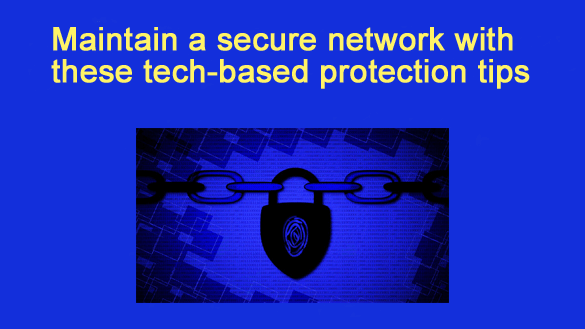 A secure network is critical. From personal devices to business infrastructures, the risks of cyberattacks, data breaches, and unauthorized access are rising at alarming rates.
A secure network is critical. From personal devices to business infrastructures, the risks of cyberattacks, data breaches, and unauthorized access are rising at alarming rates.
Hackers are becoming more sophisticated, targeting individuals and organizations through methods like phishing, malware, ransomware, and network intrusions.
The consequences of a weak or poorly protected network can be devastating, leading to financial loss, compromised data, and damaged reputations. Advancements in technology have made it possible to establish stronger defenses and adopt strategies that minimize risks.
This blog post will outline six key tech-based protection tips that can help you maintain a secure network, whether at home or in the workplace.

Strengthen Your Firewall and Router Settings
Your first line of defense against external threats is your firewall and router. These tools act as gatekeepers, determining what traffic can enter or leave your network. Many users never adjust the default router settings provided by their Internet Service Provider (ISP), but leaving them unchanged creates vulnerabilities.
By configuring your firewall properly and customizing router settings, you can block suspicious traffic, disable remote management features, and close unused ports.
Enabling Network Address Translation (NAT) and regularly updating your router’s firmware ensures that known security flaws are patched. Taking these steps may sound technical, but modern routers often include user-friendly interfaces that make the process straightforward.
Keep Systems and Software Regularly Updated
Keeping systems and software regularly updated is a key step in protecting your network from vulnerabilities, as outdated programs can easily be exploited by cybercriminals. This includes operating systems and applications, and security tools, which rely on the latest threat intelligence to function effectively. Having NGFW and intrusion prevention systems explained can help illustrate how updated security technologies detect and block attacks, highlighting why neglecting updates can leave networks exposed. By making updates a routine habit, individuals and organizations can maintain stronger defenses, safeguard sensitive data, and minimize the risk of costly breaches.
Use Advanced Encryption Protocols
Encryption is critical in protecting the integrity and confidentiality of data traveling across your network. Outdated security protocols, such as WEP or WPA, are no longer effective against modern hacking techniques. Ensure your Wi-Fi is protected using WPA3, the latest encryption standard, which offers stronger safeguards against brute-force attacks.
For businesses or individuals managing sensitive information, consider deploying Virtual Private Networks (VPNs) to encrypt traffic end-to-end. VPNs make it much harder for cybercriminals to intercept or manipulate data when using public or shared networks. Implementing encryption enhances privacy and builds trust with clients, customers, or colleagues who rely on your network’s security.
Implement Strong Authentication Measures
Passwords remain one of the most common weak points in network security, as people often use predictable or recycled ones. Strengthening authentication practices is vital for reducing unauthorized access. Multi-factor authentication (MFA), which requires a combination of something you know (password), something you have (authentication app or token), or something you are (biometrics), offers a much stronger defense.
For businesses, identity and access management (IAM) solutions provide centralized control over user access, ensuring only authorized personnel can reach sensitive systems. Even on personal networks, using unique and complex passwords for each device or service adds an important layer of protection against hacking attempts.
Segment Your Network for Added Security
Network segmentation is a technique often used by businesses, but equally valuable for households with multiple connected devices. By dividing your network into smaller, isolated sections, you reduce the risk of a single breach compromising the entire system. For example, keeping IoT devices such as smart TVs or thermostats on a separate guest network prevents them from being an easy entry point into more critical devices like computers or servers.
Businesses can apply segmentation to separate sensitive financial data from employee browsing traffic, reducing the likelihood of widespread damage. While this may require additional configuration, most modern routers and network management tools simplify the process.
Monitor and Respond With Security Tools
Proactive monitoring is crucial for identifying suspicious activities before they escalate into full-scale attacks. Intrusion Detection Systems (IDS) and Intrusion Prevention Systems (IPS) can help monitor traffic, flag anomalies, and take preventive action.
For home users, security suites and advanced antivirus software can provide real-time alerts and protection against malware or phishing attempts.
Businesses may benefit from Security Information and Event Management (SIEM) solutions, which centralize data from multiple sources and use analytics to detect threats more efficiently. Establishing a response plan is equally important; knowing what steps to take after detecting unusual activity can minimize damage and restore security quickly.

Maintaining a secure network is an ongoing process, not a one-time task. As technology evolves, so do the tactics of cybercriminals, making it important to stay vigilant and proactive. By strengthening your firewall, using encryption, keeping systems updated, implementing strong authentication, segmenting your network, and monitoring for threats, you create multiple layers of defense that work together to protect your data.
Whether you’re safeguarding personal information at home or protecting sensitive business operations, these tech-based protection tips provide a strong foundation for network security. The time and effort invested in securing your network today will prevent greater risks and losses tomorrow.